Abstract
Let M be an Abelian monoid. A necessary and sufficient condition for the class of all Armendariz rings relative to M to coincide with the class of all Armendariz rings is given. As a consequence, we prove that has exactly three cases: the empty set, , and the class of all rings. If N is an Abelian monoid, then we prove that , which gives a partial affirmative answer to the open question of Liu in 2005 (whether R is -Armendariz if R is M-Armendariz and N-Armendariz). We also show that the other Armendariz-like rings relative to an Abelian monoid, such as M-quasi-Armendariz rings, skew M-Armendariz rings, weak M-Armendariz rings, M--Armendariz rings, nil M-Armendariz rings, upper nil M-Armendariz rings and lower nil M-Armendariz rings can be handled similarly. Some conclusions on these classes have, therefore, been generalized using these classifications.
Keywords:
Armendariz rings; M-Armendariz rings; Armendariz-like rings; Armendariz-like rings relative to an Abelian monoid MSC:
06F05; 16G30; 16S36; 20M25
1. Introduction
All rings in this paper are associative with identity element . A semigroup is a nonempty set closed under an associative binary operation. A semigroup with unity is called a monoid. A monoid with a commutative binary operation is called an Abelian monoid. Unless otherwise specified, will always stand for the unity element of a monoid, and the monoid operation is written multiplicatively. We denote the multiplicative monoid of positive integers by . The additive monoid of nonnegative integers is denoted by , and the operation is written additively. The field of rational numbers is denoted by . A relation on an arbitrary set is called a partial order if it is reflexive, transitive, and antisymmetric. A partial order is denoted by ≤ and the notation or is used to mean and . A partial order ≤ on a monoid M is said to be compatible with the monoid operation if implies and for . A monoid M with a compatible partial order ≤ is denoted by . We may use the notation to denote the compatible total order on a monoid M. is said to be strict if implies and for . designates the Cartesian product of n copies of M. For a ring R, we denote by , and the prime radical, the upper nilradical (i.e., the sum of nil ideals), and the set of all nilpotent elements of R, respectively. It is well known that .
Many authors have studied various generalizations and properties of Armendariz rings. We will list the concepts involved in this paper as follows.
In ref. [], a ring R is said to have the Armendariz property (or is an Armendariz ring) if whenever polynomials and satisfy , we have for every i and j. The term Armendariz ring was chosen because Armendariz noted in ([], Lemma 1) that reduced rings (i.e., rings without non-zero nilpotent elements) satisfy this condition. We use to denote the class of all Armendariz rings. It is well known that is a nonempty proper subclass of the class of all rings.
In [], a ring R is quasi-Armendariz if whenever , satisfy , we have for every i and j. We use to denote the class of all quasi-Armendariz rings. It is well known that is a nonempty proper subclass of the class of all rings.
Let be an endomorphism of a ring R and the identity endomorphism of R. In [], R is called a skew Armendariz ring with the endomorphism (simply, an -skew Armendariz ring) if for , in , implies for all , and We define the class
It is immediate from the definition that , and so is nonempty. The following example shows that there exists a ring R such that R is not -skew Armendariz for any endomorphism of R. Therefore, is a proper subclass of the class of all rings.
Example 1.
We consider the matrix ring over the ring of integers modulo 2. If R is α-skew Armendariz for an endomorphism α of R, then for each idempotent element by [] and so . Thus, R is Armendariz, which is a contradiction. Therefore R is not in .
In [], a ring R is called weak Armendariz if whenever polynomials , satisfy , then for each . We use to denote the class of all weak Armendariz rings. It is well known that is a nonempty proper subclass of the class of all rings.
In [], a ring R is called π-Armendariz if whenever for , in we obtain for all . We use to denote the class of all -Armendariz rings. It is known that is a nonempty proper subclass of the class of all rings by ([], Example 2.3).
In [], a ring R is said to be nil-Armendariz if whenever satisfy then we have for all and . We use to denote the class of all nil-Armendariz rings. It is known that is a nonempty proper subclass of the class of all rings by ([], Example 5.5) or ([], Example 2.34). It is immediate from the definition that .
In [], for a ring R and polynomials , over R, the following condition
is studied. It is well known that a ring R satisfies the condition if and only if R is nil-Armendariz by ([], Theorem 11). For the convenience of writing below, we also use to denote the class of all nil-Armendariz rings.
In [], a ring R is said to be Armendariz-over-prime-radical (APR) if whenever two polynomials satisfy then for all and . We use to denote the class of all APR rings. It is known that is a nonempty proper subclass of the class of all rings by ([], Example 1.8).
These previous concepts have their analogs in semigroup rings. We conclude this section with some definitions to keep in mind in the sequel.
Let M be a monoid and the monoid ring of M over a coefficient ring R. In [], R is called an M-Armendariz ring (an Armendariz ring relative to M), if whenever elements , satisfy , then for each . We use to denote the class of all Armendariz rings relative to M. It is clear that and coincides with the class of all rings. It is immediate from the definition that when N is a submonoid of M.
Let M be a monoid. In [,] and independently in [], a ring R is called an M-quasi-Armendariz ring (a quasi-Armendariz ring relative to the monoid M) if whenever satisfy , then for each . We use to denote the class of all quasi-Armendariz rings relative to the monoid M. It is clear that and coincides with the class of all rings. If M is an Abelian monoid and N is a submonoid of M, then by ([], Lemma 1.14) and ([], Proposition 3.2).
Let R be a ring, M a monoid, a monoid homomorphism and the identity endomorphism of R. In [], R is called a skew Armendariz ring relative to M (or simply skew M-Armendariz) if whenever two elements and of satisfy , then for each and , where is the skew monoid ring (induced by the monoid homomorphism ). We define the class
It is clear that , , when N is a submonoid of M. We know that coincides with the class of all rings.
Let R be a ring and M a monoid. In [], R is called a weak M-Armendariz ring if whenever in satisfy , then for each i and j. We use to denote the class of all weak M-Armendariz rings. It is immediate from the definition that , when N is a submonoid of M. We know that coincides with the class of all rings.
Let R be a ring and M a monoid. In [], R is called an M-π-Armendariz ring (a -Armendariz ring relative to M), if whenever , satisfy , then for each . We use to denote the class of all M--Armendariz rings. It is immediate from the definition that , when N is a submonoid of M. We know that coincides with the class of all rings.
Let R be a ring and M a monoid. In [] and independently in [,], R is said to be nil-Armendariz relative to M (nil M-Armendariz or M-nil-Armendariz) if whenever element and in satisfy , then for each i and j. We use to denote the class of all nil M-Armendariz rings. It is immediate from the definition that , when N is a submonoid of M. We know that coincides with the class of all rings.
Let R be a ring and M a monoid. In [], R is said to be upper nil M-Armendariz if whenever elements and in satisfy , then for each i and j. We use to denote the class of all upper nil M-Armendariz rings. It is clear that and when N is a submonoid of M. It is immediate from the definition that coincides with the class of all rings.
Let R be a ring and M a monoid. In [], a ring R is said to be lower nil M-Armendariz, if whenever element , satisfy , then for all i, j. We use to denote the class of all nil M-Armendariz rings. It is immediate from the definition that , when N is a submonoid of M. We know that coincides with the class of all rings.
The following statement may bring convenience. When “Armendariz rings” appear, we consider them to be the rings in . When “Armendariz-like rings” appear, we consider them to be the rings in , , , , , , , and . When “Armendariz rings relative to an Abelian monoid” appear, we consider them to be the rings in . When “Armendariz-like rings relative to an Abelian monoid” appear, we consider them to be the rings in , , , , , , , and .
In this article, we focus on the influence of monoid M on these classes mentioned in to , especially when M is commutative. In Section 2, classifications of these classes are given. As a consequence (see Theorem 2), we understand that has exactly three cases: the empty set, ♯, and the class of all rings, where
Section 3 is devoted to several applications of these classifications. We determine the class of Abelian monoids that admits a compatible strict total order in a new way (see Proposition 5). That is, M is cancellative and torsion-free if and only if is nonempty. The open question of [] asked whether R is -Armendariz if R is M-Armendariz and N-Armendariz. This question and the corresponding questions in other classes of Armendariz-like rings are answered in the affirmative for Abelian monoids (see Proposition 6) because we understand that . We also obtained the same results (see Propositions 7–9) without assuming which cannot be removed in much original literature. Finally, a generalization of the Lemma 3 is given (see Theorem 3), which says that multiplication behaves of a finite set of elements of M can be the same as addition does for a finite set of nonnegative integers.
2. Classifications of These Classes
Recall that an element of a monoid M is left cancellative if implies for . The right cancellativity is defined similarly. If every element is left and right cancellative, M is said to be cancellative. The results similar to the following two propositions can be found in the literature (see ([], Lemma 2.2), ([], Proposition 2.13), ([], Lemma 4.2), ([], Proposition 2.27), ([], Lemma 2) and ([], Lemma 2.4)). We give proofs for completeness.
Proposition 1.
If an Abelian monoid M is not cancellative, then the class is empty, where
Proof.
Suppose is not left cancellative. Then there are such that and .
In the special case , if is not empty, then there is a ring . Thus, , giving a contradiction.
If and , then , which is also a contradiction. □
The converse of Proposition 1 need not hold by ([], Lemma 1.11).
Proposition 2.
If an Abelian monoid M contains a non-unity element of finite order, then the class is empty, where
Proof.
Suppose there is with for some positive integers . Let
Then the choice of k implies that the set has cardinality for a positive integer such that .
In the special case , if is not empty, then there is a ring . Thus, for any ,
giving a contradiction.
If and , then , giving a contradiction. □
Lemma 1.
Let M be a monoid whose all non-unity elements have infinite order, and let be such that . If
and
then .
Proof.
If , then . So and .
If , then . So and for some positive integers and . We claim that . Otherwise, if , then . Since , we have , giving a contradiction. It follows that . □
Recall that a monoid M is torsion-free if implies for any and any positive integer n.
Proposition 3.
Let M be an Abelian monoid. If M is not torsion-free, then the class is empty, where
Proof.
Suppose M is not torsion-free. Then there are distinct elements such that for a positive integer n. If is not empty, then all non-unity elements of M have infinite order by Proposition 2. Hence and . Let
By Lemma 1, . Then . Thus, and so . For convenience, let . Since is not empty, there is a ring .
In the special case , for any ,
giving a contradiction.
If , then
which is also a contradiction. □
Example 2.
The multiplicative Abelian monoid of integers is not torsion-free. Then the class is empty for each by Proposition 3.
Remark 1.
Notice that the converse of Proposition 3 is not true in general. For instance, the multiplicative Abelian monoid of nonnegative integers is torsion-free but not cancellative. So, these classes in Proposition 3 are empty by Proposition 1.
Recall that a monoid M is called a u.p.-monoid (unique product monoid) if for any two nonempty finite subsets there exists an element uniquely presented in the form where and . In ([], Proposition 5.1), it is shown that for any nontrivial u.p.-monoid M (i.e., and M is a u.p.-monoid), the class is contained in . Now we have the following.
Proposition 4.
If M is an Abelian monoid, then
where , , , , , , , .
Proof.
If , then follows from the fact that coincides with the class of all rings and ♯ is a proper subclass of the class of all rings.
If , we claim that . First, we may assume that is not empty, for the result is trivially true otherwise. Then M contains a non-unity element of infinite order by Proposition 2. Thus, is isomorphic to a submonoid of M. Therefore, . □
By Proposition 4, we know that when M is an Abelian monoid, the only class which contains ♯ as a proper subclass is , where
Corollary 1.
If M is an Abelian monoid, then
where , , , , , , , .
Proof.
If , then it is easy to see that is the class of all rings.
On the other hand, assume that is the class of all rings. If , then by Proposition 4, giving a contradiction. □
The following lemma is an easy observation that will simplify our work of checking whether a ring has Armendariz-like properties relative to an Abelian monoid. The proof of it is elementary and will be omitted.
Lemma 2.
Let and . The following statements hold for any monoid M:
- 1.
- A ring R is an M-Armendariz ring if and only if whenever Φ, satisfy , then for each ;
- 2.
- A ring R is M-quasi-Armendariz if and only if whenever Φ, satisfy , then for each ;
- 3.
- Let be a monoid homomorphism. A ring R is skew M-Armendariz if and only if whenever Φ, Ψ of satisfy , then for each ;
- 4.
- A ring R is weak M-Armendariz if and only if whenever Φ, satisfy , then for each i and j;
- 5.
- A ring R is M-π-Armendariz if and only if whenever Φ, satisfy , then for each i and j;
- 6.
- A ring R is nil M-Armendariz if and only if whenever Φ, satisfy , then for each i and j;
- 7.
- A ring R is upper nil M-Armendariz if and only if whenever Φ, satisfy , then for each i and j;
- 8.
- A ring R is lower nil M-Armendariz if and only if whenever Φ, satisfy , then for each i and j.
To characterize the connection between and a cancellative, torsion-free Abelian monoid M, we present the following lemma, which is crucial in this paper.
Lemma 3.
Let M be any Abelian monoid that is both torsion-free and cancellative. Assume that . For each positive integer m, there are n elements in such that
for each .
Proof.
Since M is a torsion-free and cancellative Abelian monoid, we can embed M in its quotient group G. Let be the embedding. As it is torsion-free and Abelian, G then embeds into , which is a -vector space (A similar argument can be found in the proof of ([], Theorem 6.31)). Let be the embedding. As we are only concerned with a subsemigroup of M generated by , we can reduce to the case that the -vector space V is finite-dimensional. After clearing denominators, we can think of the coordinates of with respect to a basis as finite tuples of integers. Moreover, by adding the same sufficiently large positive integer to each entry of these tuples, we can think of them as finite tuples of nonnegative integers. Without loss of generality, we may assume that
where each is a nonnegative integer, . Choose a positive integer
Let . By the uniqueness of p-ary representation and the injectivity of and , we have
for each . □
Example 3.
Let M be the submonoid of generated by . The quotient group G of M is the subgroup of the multiplicative group of positive rational numbers generated by . Let be the embedding. As it is torsion-free and Abelian, G then embeds into the -vector space . Let be the embedding. The set is a basis of V. The coordinates of and with respect to the basis are and , respectively. We think of them as quinary representations, then , and . Therefore for each .
It is obvious that if , where
The following theorem shows that the equality holds for any cancellative, infinite, and torsion-free Abelian monoid M.
Theorem 1.
If M is an Abelian monoid, then
where , , , , , , , .
Proof.
If , then M is cancellative and torsion-free by Propositions 1 and 3. Since coincides with the class of all rings, M is not a singleton. By Proposition 2, M is infinite.
On the other hand, if M is cancellative, infinite, and torsion-free, then by Proposition 4. For the reverse inclusion, we divide the proof into the following three cases.
Case 1: . Take any . Let
with . If the index of nilpotency of in is m, then there are n elements in such that
for each , , by Lemma 3. Let
Then . Thus, for all i and j. So by Lemma 2.
Case 2: and . Take any . Let
There are n elements in such that
for each by Lemma 3. Let
The following statements are obvious.
- If , then ;
- If , then ;
- If , then ;
- If , then ;
- If , then .
Given these facts, it is not hard to show that .
Case 3: . Take any with the endomorphism such that for some positive integer t. It follows from ([], Corollary 2) that . Since by Case 2, it follows that . Please note that . Therefore . □
Now, we have a complete classification of these classes of Armendariz-like rings relative to an Abelian monoid.
Theorem 2.
Let M be an Abelian monoid. Then, the following assertions hold for , , , , , , ,
- 1.
- If , then coincides with the class of all rings;
- 2.
- If M is cancellative, infinite and torsion-free, then ;
- 3.
- If M is not cancellative or it is not torsion-free, then is empty.
Proof.
Assume that M is cancellative and torsion-free. If , then (1) holds. If , then M is infinite. Hence (2) holds by Theorem 1. Assume that M is not cancellative, or it is not torsion-free, then is empty by Propositions 1 and 3. □
In [], a ring R is called nil-Armendariz relative to monoid , if whenever , satisfy , then for each . We denote the additive group of integers by . By Theorem 2, we know that for , , , , , , , . So, the class of all nil-Armendariz rings relative to monoid coincides with the class of all nil-Armendariz rings. One may suspect that the only nonempty class contained in ♯ is ♯ itself. This, however, may not always be the case. Notice that when a monoid M is not commutative, may be nonempty and strictly contained in by ([], Example 5.2).
3. Applications
The following proposition determines the class of Abelian monoids that admits a compatible strict total order in a new way.
Proposition 5.
Let M be an Abelian monoid. The following are equivalent for each , , , , , , ,
- 1.
- M is cancellative and torsion-free;
- 2.
- M admits a compatible strict total order;
- 3.
- is nonempty.
Proof.
Statements and are equivalent by ([], Corollary 3.4).
If , then coincides with the class of all rings. If , then M is infinite because M is cancellative and torsion-free. Thus, by Theorem 1.
This follows immediately from Propositions 1 and 3. □
As a consequence of Proposition 5, we obtain the following corollary, which is known for finitely generated Abelian groups (see ([], Theorem 1.14), ([], Theorem 1.16), ([], Proposition 2.26), ([], Theorem 2), ([], Theorem 2.8), ([], Theorem 2.10), ([] Theorem 2.24) and ([], Theorem 2.40)).
Corollary 2.
If M is a cancellative Abelian monoid, then
where , , , , , , , .
The author of [] asked whether R is -Armendariz if R is M-Armendariz and N-Armendariz. In ([], Propositions 2.6 and 2.7), affirmative results exist in the particular case. In ([], Theorems 2.7 and 2.8), affirmative results exist in the much more general cases. In ([], Theorem 3.3), ([], Theorem 3), ([], Theorem 2.17) and ([], Theorem 2.29), there are partial answers for , , and , respectively. The following proposition gives a positive answer to the open question mentioned above for Abelian monoids.
Proposition 6.
If M and N are Abelian monoids, then
for all , , , , , , , .
Proof.
We may assume that and for the result is trivially true otherwise. We know that is true because both M and N can be considered to be submonoids of . Let us prove the reverse inclusion. If or is empty, the reverse inclusion is trivially true. If and are both nonempty, then M and N are both cancellative, infinite and torsion-free by Theorem 2. So is cancellative, infinite and torsion-free. Then by Theorem 1. Therefore . □
We denote by the largest subgroup of M. is an important condition in much literature. We will show how to obtain the same conclusion without using this condition in the following three propositions. We know that a ring R is Armendariz if and only if is Armendariz by ([], Theorem 2). From ([], Proposition 2.6), if R is Armendariz and M-Armendariz, where M is a commutative and cancellative monoid with , then is Armendariz. Now, we have the following conclusion.
Proposition 7.
Let R be a ring and M an Abelian monoid. The following are equivalent:
- 1.
- R is M-Armendariz;
- 2.
- is M-Armendariz;
- 3.
- is M-Armendariz;
- 4.
- is M-Armendariz.
Proof.
We may assume that and that is not empty, for the result is trivially true otherwise. By Theorem 2, we have and M is a cancellative, infinite and torsion-free Abelian monoid. Statements and are equivalent by ([], Theorem 2). If or holds, then holds true because a subring of an M-Armendariz ring is M-Armendariz.
. If , then by ([], Theorem 2). So because . It is well known that if R is M-Armendariz and N-Armendariz, then R is -Armendariz if and only if is M-Armendariz, if and only if is N-Armendariz (see []). So . Then because .
. Let . Since is also a cancellative, infinite, and torsion-free Abelian monoid, we have by Theorem 1. Then because . □
Proposition 7 gives the following:
Corollary 3.
Let R be a ring and M an Abelian monoid. If R is Armendariz and M-Armendariz, then is Armendariz.
Proof.
If , then is Armendariz.
If , then by Theorem 2. As an immediate consequence of Proposition 7, we have . □
Remark 2.
Notice that the converse of Corollary 3 is not always true. On the one hand, it is true when is the additive Abelian monoid of nonnegative integers. On the other hand, it is not true when is the multiplicative Abelian group of and is the ring of integers modulo 2.
It was shown in ([], Propositions 3.5 and 3.6) that if R is M-quasi-Armendariz and quasi-Armendariz where M is an Abelian monoid with , then is quasi-Armendariz and is M-quasi-Armendariz. Now, we have the following conclusion.
Proposition 8.
Let R be a ring and M an Abelian monoid. If R is M-quasi-Armendariz, then and are M-quasi-Armendariz.
Proof.
If , then coincides with the class of all rings, and the result is trivially true.
If , then M is cancellative and torsion-free by Propositions 1 and 3. Thus, M is infinite and so by Theorem 2. Hence and so by ([], Theorem 3.16). Therefore, we have . Next, we show that . Suppose that
where , and , . We will show that for all i and j. It is easy to see that there exists an isomorphism of rings
via
Thus, we have . Since is M-quasi-Armendariz, it follows that . Thus, for all i, j, p and q since . Now it easy to see that for all i and j. □
Proposition 8 gives the following:
Corollary 4.
Let R be a ring and M an Abelian monoid. If R is M-quasi-Armendariz and quasi-Armendariz, then is quasi-Armendariz and is M-quasi-Armendariz.
Proof.
If , then is quasi-Armendariz and coincides with the class of all rings. If , then by Theorem 2. As an immediate consequence of Proposition 8 we have and . □
It was shown in ([], Propositions 7) that if R is a semicommutative and weak M-Armendariz where M is an Abelian and cancellative monoid such that , then is weak Armendariz. Now, we have the following conclusion.
Proposition 9.
Let M be an Abelian monoid. If R is semicommutative and weak M-Armendariz, then is weak M-Armendariz.
Proof.
If , then coincides with the class of all rings, and the result is trivially true.
If , then M is cancellative and torsion-free by Propositions 1 and 3. Thus, M is infinite and by Theorem 2. Next, we show that . Suppose that
where , and . By the isomorphism of rings in the proof of Proposition 8, we have
There are n elements in such that
for each by Lemma 3. Let
where the degree is as polynomials in x and the degree of the zero polynomial is taken to be 0. Then
and the set of coefficients of the s (resp., s) equals the set of coefficients of (resp., . Since
and , we have each . From ([], Lemma 3.1), . Thus, we have by ([], Lemma 3). □
Example 4.
Let us consider the additive Abelian group of integers. Obvious . If R is semicommutative and weak -Armendariz, then is weak -Armendariz by Proposition 9.
Proposition 9 gives the following:
Corollary 5.
Let M be an Abelian monoid. If R is semicommutative and weak M-Armendariz, then is weak Armendariz.
Proof.
If , then is weak Armendariz by ([], Corollary 3.4).
If , then by Proposition 4. As an immediate consequence of Proposition 9 we have . □
Let M be any Abelian monoid that is both torsion-free and cancellative. By Lemma 3, given a finite set of elements of M, their multiplication behaves in the same way as addition does for a finite set of nonnegative integers. However, as in Example 3, we have while . This further motivates our discussion of another choice for in Theorem 3. In the proof of Theorem 3, it will be convenient to use the following definition.
Definition 1.
Let m be a positive integer. Assume that two Abelian monoids and admit a compatible strict total order, respectively. Two n-tuples and are in the same order of degree m if for each , with , all the following three conditions hold:
- 1.
- if and only if ;
- 2.
- if and only if ;
- 3.
- if and only if .
Example 5.
Let and be Abelian monoids with the usual ordering.
Two 3-tuples and are in the same order of degree 10. However, they are not in the same order of degree 11, as
Two 4-tuples and are in the same order of degree 6. However, they are not in the same order of degree 7, as
Two 5-tuples and are in the same order of degree 2. However, they are not in the same order of degree 3, as
Theorem 3.
Assume that the Abelian monoid admits a compatible strict total order. Let . For each positive integer m, there are n elements in such that and are in the same order of degree m.
Proof.
Let . It suffices to assume that . Choose a positive integer m. By induction hypothesis, there exists such that and are in the same order of degree (in Case 1 it suffices to take ).
Case 1. There exists an equality
such that .
Without loss of generality, we may assume that . By replacing each with , we can assume that all the integers are divisible by . We define
Since and each is divisible by , it follows that is an integer. Furthermore, since , it follows from (1) that
and since and are in the same order of degree , we obtain
It follows from (2) that and thus , which shows that is a positive integer.
Now, let us consider any expression
such that , where . We show that
Case 2: The following three conditions are established simultaneously.
- Each equation with has ;
- Each inequality with has ;
- Each inequality with has .
Without loss of generality, we may assume these inequalities can be reduced to
where . Multiplying the appropriate power of the inequalities in (5) by some of , we have
with the unified right side, where is the lowest common multiple of , . Let
be the maximum amount of these . There is sufficiently large to make the inequality
true. Since and are in the same order of degree , we have
by the maximality of . Then, we have the following inequalities
Case 3: The following three conditions are established simultaneously.
- Each equation with has ;
- There exist inequalitiessuch that and
- There exist inequalitiessuch that and .
As in Case 2, we may assume that those inequalities can be rewritten as
and
with the unified item , where . Let be the maximum value of the left side of (7) and the minimum value of the right side of (8). By the density of rational numbers, there is a rational number satisfying the following inequality
The value of can be calculated using various methods (detailed discussion can be found in Appendix A).
4. Conclusions
In this paper, we explore the necessary and sufficient conditions under which the class of all Armendariz-like rings, relative to an Abelian monoid M, coincides with the class of all Armendariz-like rings. We have shown that M-Armendariz-like rings are, indeed, Armendariz-like rings for any nontrivial Abelian monoid M. We have established a connection between a cancellative, torsion-free Abelian monoid M and the monoid of nonnegative integers under addition. We provide a partial affirmative resolution to an open question posed by Liu in 2005. All monoids considered in this paper have been assumed to be commutative but some of the results in this paper are meaningful for noncommutative monoids. For instance, we have that Propositions 1 and 2 hold for noncommutative monoid when . In addition to these classes of Armendariz-like rings relative to a monoid mentioned above, many papers further propose the study of rings with an analog of the Armendariz condition defined concerning power series rings where the Lemma 3 seems to not be generalizable to infinitely many elements.
Author Contributions
Formal analysis, Y.M.; Writing—original draft, J.H.; Writing—review and editing, J.H. All authors have read and agreed to the published version of the manuscript.
Funding
This research was funded by the National Natural Science Foundation of China, grant number 12171230.
Institutional Review Board Statement
Not applicable.
Informed Consent Statement
Not applicable.
Data Availability Statement
Data are contained within the article.
Acknowledgments
We thank three anonymous referees for their comments to improve the manuscript. We wish to thank Zhongkui Liu and Nanqing Ding for their encouragement and guidance.
Conflicts of Interest
The authors declare no conflicts of interest.
Appendix A
The existence of is guaranteed by Theorem 3. The value of can be calculated in three methods: linear programming, curve straightening, and traversal algorithm. To illustrate these, we consider Example 3 again. Let and be Abelian monoids with the usual ordering.
Before presenting Method 1, let us first describe a graph that is helpful for our discussion. For the convenience of judging whether two tuples are in the same order of some degree, we can use the multiplication table of them. Take and for example. The multiplication tables of them are illustrated in Figure A1 and Figure A2.
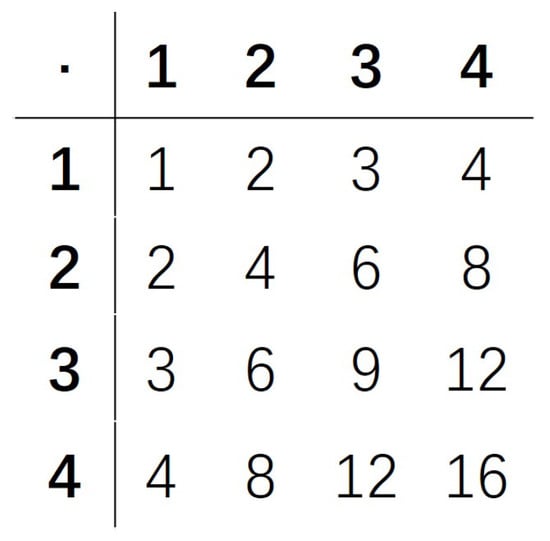
Figure A1.
The multiplication table of .
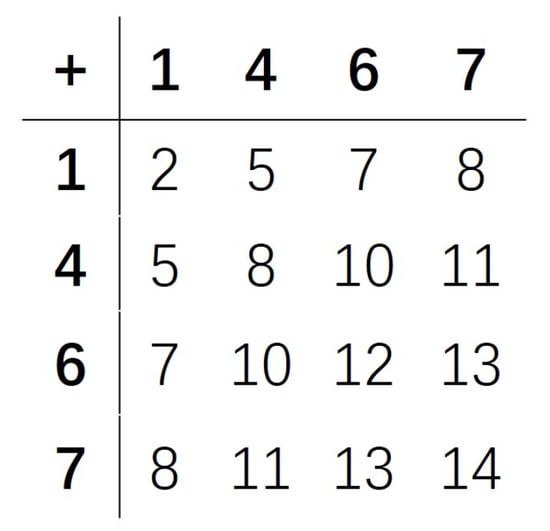
Figure A2.
The multiplication table of .
We connect the equal values in the tables of Figure A1 and Figure A2 with curves. If a value is unique, then draw a curve passing through it (see Figure A3 and Figure A4). Because Figure A3 and Figure A4 are the same at any curves, they are in the same order of degree 2. It is easy to see that they are in the same order of degree 2 if and only if the curves in Figure A3 and Figure A4 are the same.

Figure A3.
The multiplication table of with curves.

Figure A4.
The multiplication table of with curves.
Since we are in order monoids, the column and row headers of the tables can always be arranged from small to large. Select different values in Figure A1 and Figure A2 to form the column headers of Figure A5 and Figure A6, respectively. We now have the following two multiplication tables.
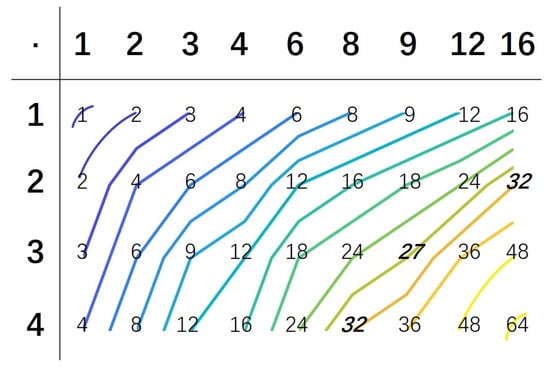
Figure A5.
The multiplication table of degree 3 of with curves.

Figure A6.
The multiplication table of degree 3 of with curves.
Because Figure A5 and Figure A6 are different at some curves, they are not in the same order of degree 3.
Method 1: Assume that two 4-tuples and are the same order of degree 2. By Definition 1, we derive the equations that needs to satisfy based on the types of equations that can generate. By simplifying the equations satisfied by , we transform the search for into the following LP problem:
The optimal solution is . Because Figure A3 and Figure A7 are same at any curves, we have and are in the same order of degree 2. Generally, the LP problem obtained in this way has feasible solutions by Theorem 3.
Method 2: If we let the column and row headers in Figure A7 grow continuously from 0, these curves in Figure A7 will be straightened in Figure A8.
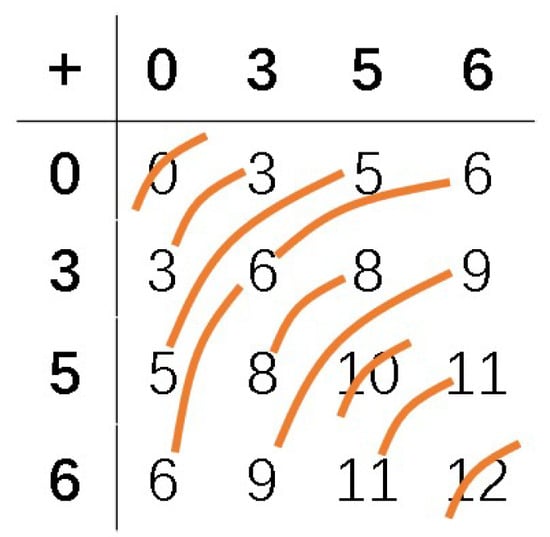
Figure A7.
The multiplication table of with curves.
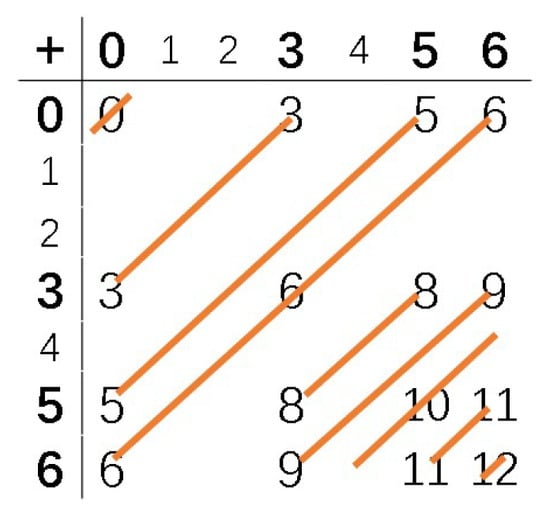
Figure A8.
The multiplication table of with straight lines.
Enlightened by this, we can find right on the graph. To take the graph seriously, we replace the values in the multiplication table with • (see Figure A9).
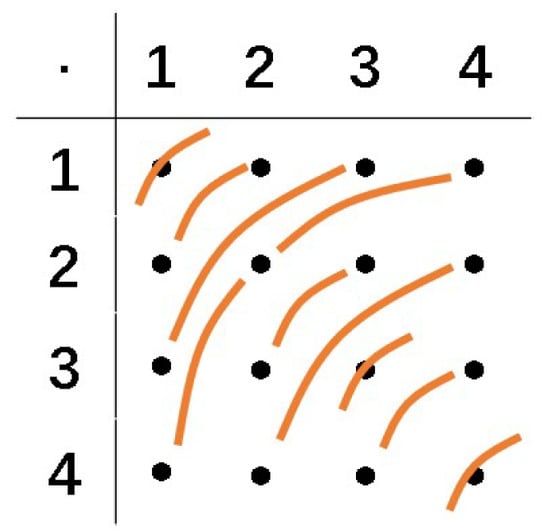
Figure A9.
The graph of with curves.
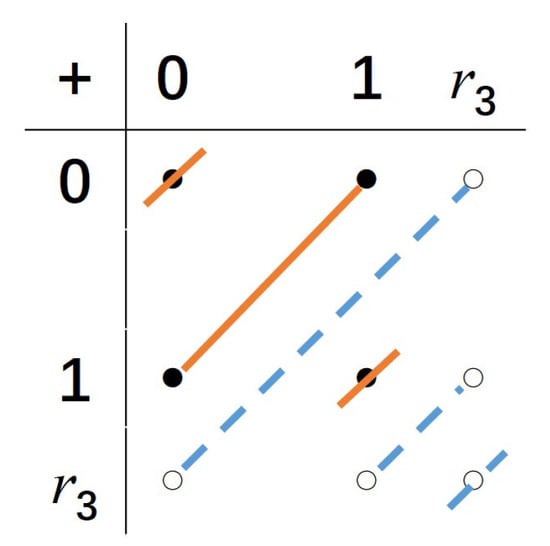
Figure A10.
The graph we need.
If and , then two 2-tuples and are in the same order of degree 2. If there is such that and are in the same order of degree 2, then we need to have a graph like Figure A10 (where we denote the values relative to by ∘ and the curves relative to ∘ by dashed lines). Although this is impossible in , there is a solution in . and are in the same order of degree 2 (see Figure A11), where is the additive monoid of nonnegative rational numbers with the usual ordering.
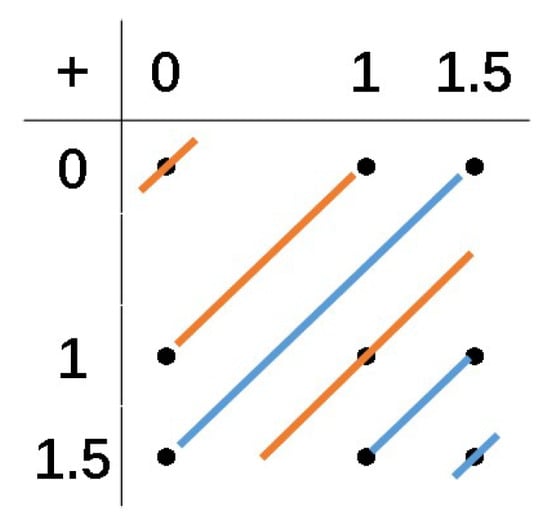
Figure A11.
The graph of .
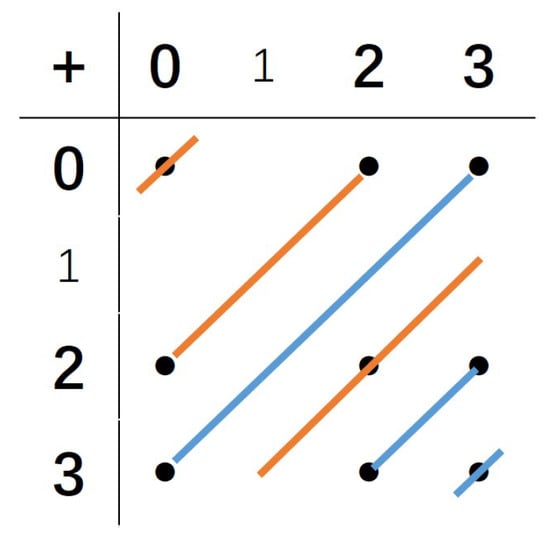
Figure A12.
The graph of .
If we straighten the curves in the multiplication table of , then we have Figure A12. Because multiplying by a positive integer does not change the order between two rational numbers, we have and are in the same order of degree 2. If two 4-tuples and are in the same order of degree 2, then if and only if . So . However, and are not in the same order of degree 2 (see Figure A13).

Figure A13.
The multiplication table of with curves.
The reason for this is that the degree of the same order between and is not large enough. In fact, and are not in the same order of degree 3, as while . We go back to the case of 2-tuple and replace with . This gives us a chance to choose a better value for . In fact, if , then and are in the same order of degree 4. We can check this by the multiplication tables in Figure A14 and Figure A15.
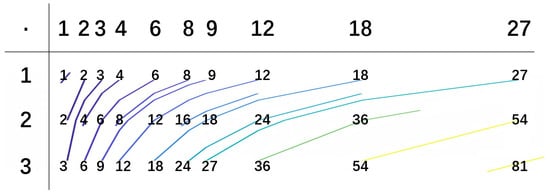
Figure A14.
The multiplication table of degree 4 of with curves.
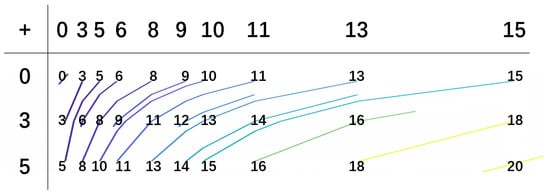
Figure A15.
The multiplication table of degree 4 of with curves.
Since , we have . Because Figure A3 and Figure A7 are same at any curves, we have and are in the same order of degree 2. Figure A3, Figure A4, Figure A5, Figure A6, Figure A7 and Figure A8, the whole process is like straightening the curves.
Method 3: We can search in the subset of by traversal algorithm. Then we have that and are in the same order of degree 2. When the data are large, Method 3 is more effective. For example, we have that and are in the same order of degree 2 (see Figure A16 and Figure A17) by traversal algorithm.
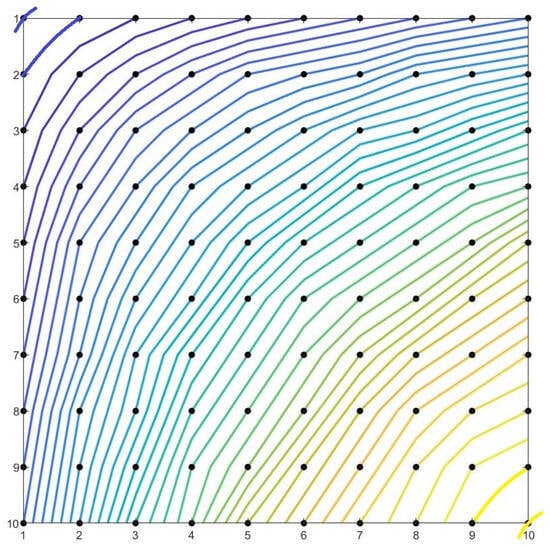
Figure A16.
The graph of .
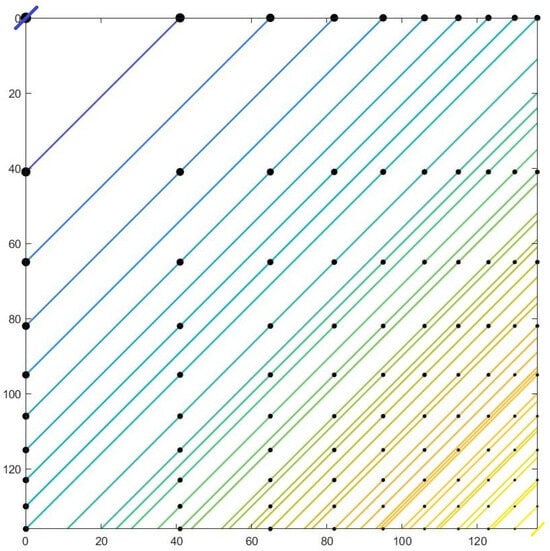
Figure A17.
The graph of .
References
- Rege, M.B.; Chhawchharia, S. Armendariz rings. Proc. Jpn. Acad. 1997, 73, 14–17. [Google Scholar] [CrossRef]
- Armendariz, E.P. A note on extensions of Baer and P.P.-rings. J. Aust. Math. Soc. 1974, 18, 470–473. [Google Scholar] [CrossRef]
- Hirano, Y. On annihilator ideals of a polynomial ring over a noncommutative ring. J. Pure Appl. Algebra 2002, 168, 45–52. [Google Scholar] [CrossRef]
- Hong, C.Y.; Kim, N.K.; Kwak, T.K. On Skew Armendariz Rings. Commun. Algebra 2003, 31, 103–122. [Google Scholar] [CrossRef]
- Moussavi, A.; Hashemi, E. On (α, δ)-skew Armendariz rings. J. Korean Math. Soc. 2005, 42, 353–363. [Google Scholar] [CrossRef]
- Liu, Z.-K.; Zhao, R.-Y. On Weak Armendariz Rings. Commun. Algebra 2006, 34, 2607–2616. [Google Scholar] [CrossRef]
- Huh, C.; Lee, C.I.; Park, K.S.; Ryu, S.J. On Π-Armendariz rings. Bull. Korean Math. Soc. 2007, 44, 641–649. [Google Scholar] [CrossRef]
- Antoine, R. Nilpotent elements and Armendariz rings. J. Algebra 2008, 319, 3128–3140. [Google Scholar] [CrossRef][Green Version]
- Alhevaz, A.; Moussavi, A. On monoid rings over nil Armendariz ring. Commun. Algebra 2014, 42, 1–21. [Google Scholar] [CrossRef]
- Jung, D.W.; Kim, N.K.; Lee, Y.; Yang, S.P. Nil-Armendariz rings and upper nilradicals. Int. J. Algebra Comput. 2012, 22, 1250059. [Google Scholar] [CrossRef]
- Han, J.; Kim, H.K.; Lee, Y. Armendariz property over prime radicals. J. Korean Math. Soc. 2013, 50, 973–989. [Google Scholar] [CrossRef]
- Liu, Z.-K. Armendariz rings relative to a monoid. Commun. Algebra 2005, 33, 649–661. [Google Scholar] [CrossRef]
- Hashemi, E. Some examples of quasi-Armendariz rings. Bull. Korean Math. Soc. 2007, 44, 407–414. [Google Scholar] [CrossRef]
- Hashemi, E. Quasi-Armendariz rings relative to a monoid. J. Pure Appl. Algebra 2007, 211, 374–382. [Google Scholar] [CrossRef][Green Version]
- Liu, Z.-K.; Zhang, W.-H. Quasi-Armendariz rings relative to a monoid. Commun. Algebra 2008, 36, 928–947. [Google Scholar] [CrossRef]
- Habibi, M.; Manaviyat, R. A generalization of nil-Armendariz rings. J. Algebra Appl. 2013, 12, 1350001. [Google Scholar] [CrossRef]
- Zhang, C.-P.; Chen, J.-L. Weak M-Armendariz rings. J. Southeast Univ. (Engl. Ed.) 2009, 25, 142–146. [Google Scholar] [CrossRef]
- Ouyang, L.-Q.; Liu, J.-W. On a generalization of the π-Armendariz condition. Int. Math. Forum 2011, 6, 3349–3356. [Google Scholar]
- Habibi, M.; Moussavi, A. Nilpotent elements and nil-Armendariz property of monoid rings. J. Algebra Appl. 2012, 11, 1250080. [Google Scholar] [CrossRef]
- Hashemi, E. Nil-Armendariz rings relative to a monoid. Mediterr. J. Math. 2013, 10, 111–121. [Google Scholar] [CrossRef]
- Ouyang, L.-Q.; Liu, J.-W. Nil-Armendariz rings relative to a monoid. Arab. J. Math. 2013, 2, 81–90. [Google Scholar] [CrossRef][Green Version]
- Alhevaz, A.; Hashemi, E.; Ziembowski, M. Nilradicals of the unique product monoid rings. J. Algebra Appl. 2017, 16, 1750133. [Google Scholar] [CrossRef]
- Marks, G.; Mazurek, R.; Ziembowski, M. A unified approach to various generalizations of Armendariz rings. Bull. Aust. Math. Soc. 2010, 81, 361–397. [Google Scholar] [CrossRef]
- Paykan, K.; Moussavi, A. Quasi-Armendariz generalized power series rings. J. Algebra Appl. 2016, 15, 1650086. [Google Scholar] [CrossRef]
- Mazurek, R.; Ziembowski, M. On a characterization of distributive rings via saturations and its applications to Armendariz and Gaussian rings. Rev. Mat. Iberoam. 2014, 30, 1073–1088. [Google Scholar] [CrossRef]
- Lam, T.Y. A First Course in Noncommutative Rings; Springer: New York, NY, USA, 1991. [Google Scholar]
- He, J.-W.; Guo, L.-Q. Armendariz rings and α-skew Armendariz rings. Basic Sci. J. Text. Univ. 2010, 23, 4–6. [Google Scholar] [CrossRef]
- Gilmer, R. Commutative Semigroup Rings; The University of Chicago Press: Chicago, IL, USA, 1984. [Google Scholar]
- Wang, Y.; Jiang, M.-M.; Ren, Y.-L. π-Armendariz rings relative to a monoid. Front. Math. China 2016, 11, 1017–1036. [Google Scholar] [CrossRef]
- Anderson, D.D.; Camillo, V. Armendariz rings and Gaussian rings. Commun. Algebra 1998, 26, 2265–2272. [Google Scholar] [CrossRef]
Disclaimer/Publisher’s Note: The statements, opinions and data contained in all publications are solely those of the individual author(s) and contributor(s) and not of MDPI and/or the editor(s). MDPI and/or the editor(s) disclaim responsibility for any injury to people or property resulting from any ideas, methods, instructions or products referred to in the content. |
© 2025 by the authors. Licensee MDPI, Basel, Switzerland. This article is an open access article distributed under the terms and conditions of the Creative Commons Attribution (CC BY) license (https://creativecommons.org/licenses/by/4.0/).